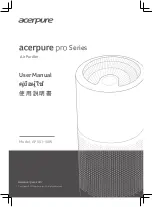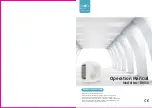
-
70
-
'20 • PAC-SM-351
(c) Outdoor inverter PCB replacement procedure
Precautions for Safety
• Since the following precaution is the important contents for safety, be sure to observe them.
WARNING and CAUTION are described as follows:
WARNING
Indicates an imminently hazardous situation which will result in death or serious
injury if proper safety procedures and instructions are not adhered to.
Indicates a potentially hazardous situation which may result in minor or moderate
injury if proper safety procedures and instructions are not adhered to.
CAUTION
WARNING
• Securely replace the PCB according to this procedure.
If the PCB is incorrectly replaced, it will cause an electric shock or fire.
• Be sure to check that the power source for the outdoor unit is turned OFF before replacing the
PCB. The PCB replacement under current-carrying will cause an electric shock or fire.
• After finishing the PCB replacement, check that wiring is correctly connected with the PCB before
power distribution. If the PCB is incorrectly replaced, it will cause an electric shock or fire.
CAUTION
• Band the wiring so as not to tense because it will cause an electric shock.
Replace the inverter PCB according to the following procedure.
㸟
㸟
㸟
㸟
(i) Model FDC71VNX
1)
Replace the PCB
after elapsing 3 minutes from power OFF
.
(High voltage is retained on the capacitor after turning the power off. It is very dangerous to touch the PCB
in this condition.)
I
n the situation that harnesses are connected to inverter PCB
be sure to measure voltage (DC)
between T26
and T27 on inverter PCB, and
check that the voltage is discharged sufficiently
. (Refer to Fig.2).
2) Disconnect the connectors and faston terminals from the inverter PCB as shown in Fig. 1.
3)
Match the setting of switches (JSW10, 11) of new PCB with former PCB.
4) Remove the harness bands (3 places) from the control unit, then remove the fixing screws (4places) from the
radiator. (Refer to Fig.3)
5) Remove the inverter PCB with radiator from the control unit, and exchange the inverter PCB with radiator.
Be careful not to pinch the wiring at the time of exchanging.
6) Fix the radiator to the control unit by screws. After exchanging the inverter PCB, reconnect the connectors, faston
terminals and the harnesses as before. (Confirm that the
connectors are not half inserted
.)
7) Attach the harness bands (3 places), then reconnect the harnesses as before.
8) Install the harness clip on the inverter PCB as shown in Fig.4, and fix the harness.
Fig.1
Parts arrangement view of inverter PCB
Connectors are not half
inserted
*
Presence and shape of electric component
may vary according to model.
*( ) shows harness color.
CNI4
T52(Orange)
T26(Red)
CNO1
T27(Blue)
CNI2
JSW10,11
T62(Orange)
Parts No.
T22(White)
T21(Red)
T23(Blue)
CNG2
T28(Red)
T30(Blue)
T29(White)
T51(Yellow)
LED(Yellow)
(c) Outdoor inverter PCB replacement procedure
Precautions for Safety
• Since the following precaution is the important contents for safety, be sure to observe them.
WARNING and CAUTION are described as follows:
WARNING
Indicates an imminently hazardous situation which will result in death or serious
injury if proper safety procedures and instructions are not adhered to.
Indicates a potentially hazardous situation which may result in minor or moderate
injury if proper safety procedures and instructions are not adhered to.
CAUTION
WARNING
• Securely replace the PCB according to this procedure.
If the PCB is incorrectly replaced, it will cause an electric shock or fire.
• Be sure to check that the power source for the outdoor unit is turned OFF before replacing the
PCB. The PCB replacement under current-carrying will cause an electric shock or fire.
• After finishing the PCB replacement, check that wiring is correctly connected with the PCB before
power distribution. If the PCB is incorrectly replaced, it will cause an electric shock or fire.
CAUTION
• Band the wiring so as not to tense because it will cause an electric shock.
Replace the inverter PCB according to the following procedure.
㸟
㸟
㸟
㸟
(i) Model FDC71VNX
1)
Replace the PCB
after elapsing 3 minutes from power OFF
.
(High voltage is retained on the capacitor after turning the power off. It is very dangerous to touch the PCB
in this condition.)
I
n the situation that harnesses are connected to inverter PCB
be sure to measure voltage (DC)
between T26
and T27 on inverter PCB, and
check that the voltage is discharged sufficiently
. (Refer to Fig.2).
2) Disconnect the connectors and faston terminals from the inverter PCB as shown in Fig. 1.
3)
Match the setting of switches (JSW10, 11) of new PCB with former PCB.
4) Remove the harness bands (3 places) from the control unit, then remove the fixing screws (4places) from the
radiator. (Refer to Fig.3)
5) Remove the inverter PCB with radiator from the control unit, and exchange the inverter PCB with radiator.
Be careful not to pinch the wiring at the time of exchanging.
6) Fix the radiator to the control unit by screws. After exchanging the inverter PCB, reconnect the connectors, faston
terminals and the harnesses as before. (Confirm that the
connectors are not half inserted
.)
7) Attach the harness bands (3 places), then reconnect the harnesses as before.
8) Install the harness clip on the inverter PCB as shown in Fig.4, and fix the harness.
Fig.1
Parts arrangement view of inverter PCB
Connectors are not half
inserted
*
Presence and shape of electric component
may vary according to model.
*( ) shows harness color.
CNI4
T52(Orange)
T26(Red)
CNO1
T27(Blue)
CNI2
JSW10,11
T62(Orange)
Parts No.
T22(White)
T21(Red)
T23(Blue)
CNG2
T28(Red)
T30(Blue)
T29(White)
T51(Yellow)
(i) Models FDC100VNX-W, 125VNX-W, 140VNX-W
1) Replace the PCB
after elapsing 3 minutes from power OFF.
(
Be sure to measure voltage (DC)
on both capacitor terminals located in control back, and
check that
the voltage is discharged sufficiently
.
(Refer to Fig.1))
2) Take off the connection of inverter PCB terminal block connector and remove the screw of power transistor
then remove the PCB. Wipe off the silicon grease neatly on the control’s radiation heat fins.
3) Match the setting switches (JSW10,11) of new PCB with the former PCB.
4) Before installing the power transistor on the new PCB, apply uniformly a bundled of silicon grease first on the
surface of power transistor.Make sure it is applied to prevent damage on power transistor.
5) Tighten the screw of power transistor on inverter PCB and connect the terminal block.Confirm the connection
and don’t use soldering in the connection.Tighten properly the power transistor with a screw and make sure
there is no slack.Power transistor can be damage if not properly tighten.(Recommended power transistor
tightening torque:0.98 – 1.47N∙m)
TB1
TB11
Parts No.
Parts arrangement view
Fig.1 Position of capacitor
TB2
TB10
TB5
TB6
Connector
CNI2
CNI4
TB7
TB8
TB9
Voltage measurement parts
JSW10
Switch
JSW11
CNACT1
Terminal block
Terminal block
PCA565A151-1
-1
OFF
-1
OFF
-2
OFF
-2
OFF
-3
OFF
-3
ON
JSW10
-4
OFF
JSW11
-4
ON
Table. 1 Switch setting
Models FDC100VNX-W, 125VNX-W, 140VNX-W
PCA012D025D
P
LED
Содержание SRK100VNXWPZSX
Страница 2: ...1 20 PAC SM 351 TABLE OF CONTENTS 1 HYPER INVERTER PACKAGED AIR CONDITIONERS 2 2 V MULTI SYSTEM 199...
Страница 181: ...180 20 PAC SM 351 1 e SRK series PHA012D402...
Страница 182: ...181 20 PAC SM 351 Screw...
Страница 183: ...182 20 PAC SM 351 3 PHA012D402...
Страница 184: ...183 20 PAC SM 351 4 PHA012D402...
















































